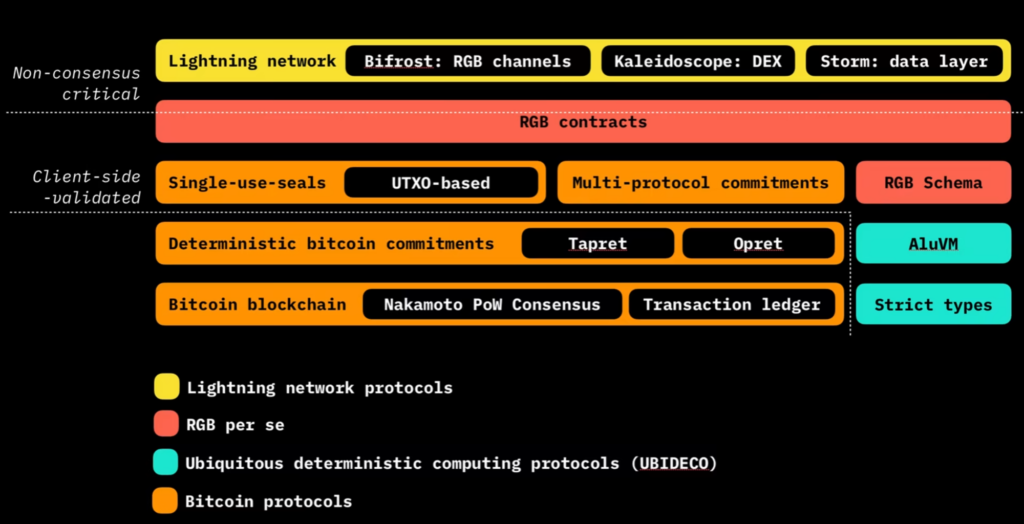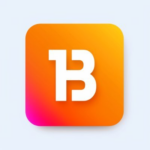By: Ash, Bitcoin Square; Sawyer, Echo, Bihelix
Introduction
Bitcoin has pioneered decentralized digital currency and blockchain technology for over a decade. Despite its innovations, Bitcoin has primarily served as a medium of exchange and store of value. However, the introduction of inscriptions by the Bitcoin Ordinals protocol and the emergence of the Runes protocol have prompted a reassessment of Bitcoin’s potential beyond just storing value. These new asset issuance protocols have reignited interest in the Bitcoin ecosystem while highlighting its scalability and transaction confirmation limitations. Against this backdrop, the RGB protocol has emerged, opening new possibilities for the Bitcoin ecosystem and injecting fresh momentum.
Overview of the RGB Protocol
1. What is the RGB Protocol?
The RGB protocol is a Layer 2 solution built on top of the Bitcoin blockchain, designed to support the creation and management of complex assets, smart contracts, and decentralized applications (dApps). By fully leveraging the native strengths of the Bitcoin network, RGB aims to transform Bitcoin into a comprehensive platform suitable for a variety of use cases, ultimately fostering the growth and expansion of the entire ecosystem.
2. Development History of the RGB Protocol
The initial concept of the RGB protocol dates back to 2016, proposed by Giacomo Zucco of BHB Network based on Peter Todd’s ideas of client-side validation and single-use seals. In 2017, BHB Network implemented RGB in the original MVP (Minimum Viable Product) with support from the Poseidon Group. In 2019, Maxim Orlovsky and Giacomo Zucco co-founded the LNP/BP Standards Association, dedicated to advancing RGB from concept to practical application.
Since 2019, Dr. Maxim Orlovsky has played a central role in developing the RGB Protocol, responsible for designing and implementing the current version of the protocol. In 2021, the LNP/BP Standards Association demonstrated the integration of RGB with the Turing-complete AluVM, marking a significant milestone. The following year, the association launched the official website for the Contractum language, a functional, declarative programming language tailored for building smart contracts using RGB technology on Bitcoin and the Lightning Network. In April 2023, the LNP/BP Standards Association released RGB v0.10, announcing a focus on developing support for the Lightning Network. In the future, RGB assets can be transferred quickly and at a low cost via the Lightning Network, enhancing asset liquidity and usability. Additionally, RGB may enable comprehensive smart contract functionality on the Lightning Network, addressing the limitations of Bitcoin and the Lightning Network in terms of smart contracts.
3. How the RGB Protocol Works
RGB is a protocol built on the PoW consensus layer of the Bitcoin blockchain. The protocol is a version of a Directed Acyclic Graph (DAG), where participants cannot see the complete state of the network. Each new transaction requires confirmation from at least two previous transactions to be recorded on the network. The RGB model supports client-side validation.

Source: RGB Blackpaper
4. Technical Highlights of the RGB Protocol
The RGB protocol leverages Bitcoin’s proof-of-work and decentralized network to prevent double-spending and ensure censorship resistance. It shifts token transfer verification to an off-chain process, performed by the recipient’s client, interacting with the Bitcoin main chain only when necessary for efficiency and privacy.
- Single-Use Seals: Ensure each UTXO can be used only once, encapsulating asset information and contract state.
- Client-Side Validation: Clients validate only relevant transactions, improving scalability but possibly increasing validation time for assets with long histories.
- Deterministic Bitcoin Commitments: Uses Taproot-based OP_RETURN commitments to aggregate state transitions, preventing double-spending by embedding the final commitment hash in a Bitcoin transaction.
- Batch Processing: Allows multiple state changes in a single Bitcoin transaction, reducing on-chain fees, suitable for large-scale transfers or UTXO consolidation.
- Privacy Protection: Uses Bitcoin transactions as containers for asset transfers, enhancing privacy by not showing transfer paths in the transaction graph. Off-chain communication secures payment information transmission and verification, protecting user activity privacy.
Use Cases and Significance of the RGB Protocol
1. Fully Leveraging Bitcoin’s Monetary Properties
Bitcoin (BTC) derives its long-term value from the breadth and depth of its application ecosystem. Similar to how the US dollar became a global currency through widespread use in global economies and commerce, Bitcoin needs a similar value system to support large transactions. The RGB protocol addresses Bitcoin’s scalability and Turing completeness issues, enabling the creation of a value transmission system based on BTC. This introduces numerous commercial applications, enhancing Bitcoin’s ecosystem and enabling it to support more complex financial and commercial activities, thus increasing BTC’s value and application prospects.
2. Tokenization of Native Bitcoin Assets
The RGB protocol facilitates the tokenization of various assets on the Bitcoin blockchain. This means almost any asset, digital or physical, can be represented as unique tokens or “RGB assets” on the Bitcoin network. Examples include real estate, artwork, commodities, securities, and NFTs. This capability opens up new opportunities for asset management, trading, and investment within the Bitcoin ecosystem. Tokenized assets can be easily transferred on the Bitcoin blockchain, providing greater security, transparency, and liquidity.
3. Smart Contracts and Decentralized Applications
The RGB protocol’s smart contract functionality enables the implementation of complex financial products and services on the Bitcoin blockchain. Smart contracts are self-executing programs that automatically execute when predefined conditions are met, eliminating the need for third parties and reducing the risk of fraud or manipulation. With the RGB protocol, developers can build decentralized applications (dApps) that automate various processes using smart contracts. This extends Bitcoin’s traditional monetary role and creates an ecosystem of decentralized applications and services on the Bitcoin network.
4. Scalability and Security
While introducing new functionalities, the RGB protocol also addresses key issues of scalability and security. By using the OP_RETURN field in Bitcoin transactions to store asset metadata, RGB minimizes the impact on the Bitcoin blockchain size, maintaining its scalability and efficiency. Leveraging Bitcoin’s security and decentralization, the RGB protocol provides a secure and reliable platform for these applications. These decentralized applications not only enhance the functionality of the Bitcoin network but also promote wider adoption and participation, driving the development of the Bitcoin ecosystem.
RGB Ecosystem Projects
BiHelix
BiHelix is a Bitcoin-native blockchain project that combines the RGB protocol and the Lightning Network to build optimized node infrastructure, aimed at promoting Bitcoin for large-scale applications. Its main focus areas are as follows:
- Node Optimization: BiHelix will develop RGB supernodes that link to the Lightning Network. These supernodes will serve as the core product of the ecosystem. Through node optimization, BiHelix aims to enhance network performance and efficiency, enabling it to handle more transactions and more complex applications, thereby providing a robust infrastructure for the Bitcoin ecosystem.
- AluVM Modification and Decentralized Schema Store Development: BiHelix will modify AluVM, a purely functional RISC virtual machine designed for developing advanced smart contracts. Unlike other virtual machines, AluVM is register-based and does not allow random memory access, making it more robust and secure. BiHelix will also build a decentralized Schema Store to store and manage the structure and specifications of smart contracts, enhancing their flexibility and scalability.
- Storage Optimization: BiHelix is researching and optimizing the use of a database storage method to replace the existing RGB Stash file storage format. This improvement will enhance data management efficiency and reliability, making large-scale data processing and access more efficient and providing a solid foundation for future expansion.
- Protocol Architecture Optimization: BiHelix is committed to optimizing the entire protocol architecture. Firstly, it will introduce node communication protocols (such as the Nostr protocol) to improve the issue of single node users being unable to communicate historical data, thereby enhancing network interoperability. Secondly, it will adopt recursive zero-knowledge proof technology to address the problem of excessive data validation, enhancing network privacy and security. Ultimately, these improvements will significantly enhance the engineering capability and application potential of the RGB protocol.
Through these measures, BiHelix not only enhances the infrastructure capacity of the Bitcoin network but also provides solid technical support for various innovative applications. Ultimately, BiHelix’s efforts will propel Bitcoin from a simple store of value to a multifunctional, multi-application decentralized platform, achieving a comprehensive upgrade and expansion of the Bitcoin ecosystem. In the near future, we can also expect the launch of BiHelix nodes based on RGB and Lightning Network in mainstream wallets.
Summary
Over six years of development, the RGB protocol has not yet become widespread, but its potential is immense. The new version v0.10 expands asset issuance and smart contract capabilities, gradually approaching full compatibility with the Lightning Network. Time will tell whether this will become a catalyst for RGB’s development, but it holds the potential to catalyze the evolution of the Bitcoin ecosystem, transforming it from a mere value currency into a comprehensive platform for decentralized applications, tokenized assets, and smart contracts. By unlocking new use cases, RGB, as a key infrastructure, can play a crucial role in shaping the future of Bitcoin and the broader cryptocurrency landscape, heralding innovation in the crypto world.


